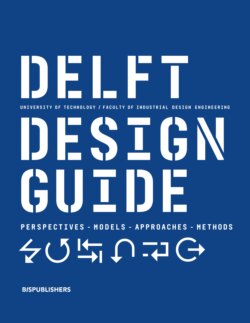Читать книгу Delft Design Guide -Revised edition - Annemiek van Boeijen - Страница 26
На сайте Литреса книга снята с продажи.
Оглавление22. Design for Emotion
How? You can use various methods to measure emotions, such as PrEmo (see ‘Product Emotion Measurement Instrument’). You can also use interview techniques to explore the relationship between emotions and the underlying goals and needs:
--------
Concerns: Determine the underlying con- cerns of the user by asking three ques- tions. First, what are their goals? These can refer to objectives such as things they want to accomplish or see happen. Second, what are their standards? This can involve the expectations and beliefs about how they themselves, other people, and objects should behave or act. Lastly, what are their attitudes? This refers to dispositional likings or dislikings for qualities of objects, people, or activities. All these concerns should be formulated
not only in relation to objects – as in, the product to be designed – but also in relation to the activity that is enabled or supported by the use of the product and in relation to the people (including the user) who are involved in the context of use.
--------
Response: Observe current emotional responses in the context of use. This can help you determine user concerns. These existing emotions are used as entry points in interviews to understand underlying concerns.
--------
Conflicts: Formulate possible conflicts between user concerns. These conflicts are then used to formulate new design solution spaces. The emotional impact of concepts can be tested with the use of PrEmo.
Design for Emotion
What & Why? Design for Emotion offers a systematic approach to designing products with predefined emotional intentions. The approach can be used to (a) define an appropriate emotional effect, (b) gather relevant user information so that this emotional effect can be achieved, (c) envision concepts that evoke the intended effect, and (d) measure to what extent the design concept evokes the intended emotion. The approach is based on a basic model of emotion in design where designers distinguish between the different layers of emotion that should be taken into consideration in design processes.
The key variables in the model are stimulus and concern. With regard to stimulus, design can provide emotional stimuli on three levels: object, usage, and context. With concern, there are three types of user concerns that are relevant here, namely the goals, standards, and attitudes of users. These two variables combine to form a matrix of nine sources of product emotion.
-------------------------------------------------------------------------------------------------------------------
Mindset: The perspective is based on a cognitive approach to analysing emotions that builds on an evolutionary perspective of human experience. Emotions play a central role in the human ability to understand and learn about the world. Positive experiences kindle our curiosity, and negative ones protect us from repeating mistakes. It requires an analytical view on emotions and a research-informed design approach.
-------------------------------------------------------------------------------------------------------------------
References & Further Reading: Desmet, P.M.A., 2012. Faces of Product Pleasure; 25 Positive Emotions in Human-Product Interactions. International Journal of Design, 6(2), pp. 1-29. / Desmet, P.M.A., Fokkinga, S.F., Ozkaramanli, D., & Yoon, J., 2016. Emotion-driven product design . In: H.L. Meiselman (Ed.), Emotion Measurement (pp. 405-426). Amsterdam: Elsevier. / Desmet, P.M.A. & Schifferstein, N.J.H., 2012. Emotion research as input for product design. In J. Beckley, D. Paredes, & K. Lopetcharat (Eds.), Product Innovation Toolbox: A Field Guide to Consumer Understanding and Research (pp. 149-175). Hoboken, NJ: John Wiley & Sons. / Ozkaramanli, D. & Desmet, P.M.A., 2012. I know I shouldn’t, yet I did it again! Emo- tion-driven design as a means to subjective wellbeing. International Journal of Design , 6(1), pp. 27-39.
Tips & Concerns
At least 25 different emotions can be experienced in human- product interaction. In the design process, the intended emotions should be defined because different emotions require different designs.
--------
Design for Emotion involves designing for concerns; therefore, this approach always requires a research stage in which user concerns are determined.
--------
Concerns should be formulated as ‘I want…’, ‘I should / someone should / a product should...’ or ‘I like….’
--------
The formulation should be concrete, and concern sets should include not only goals but also standards and attitudes.
-------------------------------
Limitations
Design for Emotion focuses on emotional effects of design, but it does not necessarily take other relevant aspects or requirements into consideration. The approach should therefore be incorporated into regular design approaches rather than used in isolation.
--------
Although the basic concepts in the approach are easy to understand, using them in design processes does require some experience.
Design for Emotion is a perspective on design that takes the intended emotional impact as the leading principle in the design process.
perspectives
---------------------------------------------------------------------------------------------------------------------------------------------------------------
25
